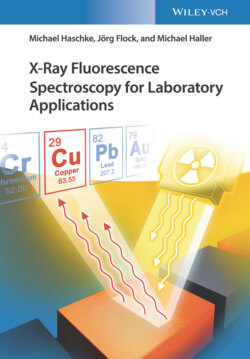Читать книгу X-Ray Fluorescence Spectroscopy for Laboratory Applications - Michael Haschke, Jörg Flock - Страница 3
List of Tables
Оглавление1 Chapter 2Table 2.1 Approximate relative line intensities of main X-ray lines.Table 2.2 Comparison of line designations for the main X-ray lines.
2 Chapter 3Table 3.1 Preparation technologies for solid samples.Table 3.2 Information depth for different fluorescence lines in various mater...Table 3.3 Information depth and accumulated intensity in the case of 10 wt% N...Table 3.4 Estimations of the sample volume and mass that contribute to the me...Table 3.5 Contaminations in the range of traces by preparation tools (main co...Table 3.6 Steps for processing and sampling of small part materials.Table 3.7 Mills for fine grinding of powder-like material.Table 3.8 Binders and additives for pressed pellets.Table 3.9 Flux agents for different applications.Table 3.10 Sample–flux ratios for typical materials in grams (valid for diame...Table 3.11 Window materials for sample cups for liquid samples.
3 Chapter 4Table 4.1 Comparison of wavelength- and energy-dispersive X-ray spectrometer ...Table 4.2 Often used crystals for wavelength-dispersive spectrometry.Table 4.3 Instrument setup parameters.Table 4.4 Products offered by instrument manufacturers for different instrume...
4 Chapter 5Table 5.1 Contributions to the Cr intensity by primary, secondary, and tertia...Table 5.2 Relative statistical error as a function of the number of counts.Table 5.3 Substances suitable for standard addition.Table 5.4 Analytical uncertainties for different sample qualities, measuring ...Table 5.5 Settings for the preparation of an analytical method.
5 Chapter 6Table 6.1 Results of repeated intensity measurements.Table 6.2 Student'st-distribution in dependence of the probability p and the ...Table 6.3 Addition of error contributions.Table 6.4 Number of significant figures typical for X-ray fluorescence.
6 Chapter 7Table 7.1 Comparison of methods for element analyses.
7 Chapter 8Table 8.1 Relative sensitivities of different body parts.Table 8.2 Radiation levels depending on dose.
8 Chapter 9Table 9.1 Mean deviations for a cast iron calibration.Table 9.2 Typical analytical performance of WD spectrometers for low-alloy st...Table 9.3 Analytical performance of WD spectrometers for stainless steel.Table 9.4 Analytical performance of WD spectrometers for tool steel.Table 9.5 Analytical performance of WD spectrometers for the analysis of Al a...Table 9.6 Composition of eutectics of soft solders.Table 9.7 Analytical performance for the analyses of soft solders.Table 9.8 Accuracies for the analysis of gold alloys.Table 9.9 Relative standard deviations of repeated measurements depending on ...Table 9.10 Typical composition and measurement uncertainties of flat glasses.Table 9.11 Polymers and their approximate composition and mass fractions in w...Table 9.12 Correlation coefficientsR2 for different energy resolutions.Table 9.13 Mass fractions of hydrocarbon groups and H, N, and O for PUR and A...
9 Chapter 10Table 10.1 Detection limits for some heavy elements using K-radiation.Table 10.2 Maximum loads of soils and sewage sludge.Table 10.3 Typical compositions of components for the cement production in wt...Table 10.4 Relative standard deviations of repeated measurements for samples ...Table 10.5 Concentrations of typical ferroalloys in wt%.Table 10.6 Digestion procedures for different Ferroalloys.Table 10.7 Analyses results of ferro-silicon using powder samples in wt%.Table 10.8 Relative standard deviationσrel of repeated measurements of s...Table 10.9 Mass fractions ranges of refractory materials.Table 10.10 Results of repeated measurements on a refractory.Table 10.11 Average limits for toxic elements in animal food.Table 10.12 Comparison between calibration results and limits of detection fo...Table 10.13 Maximal amount of intake of toxic elements per day in micrograms.Table 10.14 Reference values for the content of heavy metals in secondary fue...Table 10.15 Typical line overlaps for toxic elements.Table 10.16 Results of repeated measurements for secondary fuels.Table 10.17 Reproducibility and trueness of the analyses of toxic liquids.
10 Chapter 11Table 11.1 Limit of detection forS in fuels depending on the measuring method...Table 11.2 Repeatability and reproducibility limits for the detection of sulf...Table 11.3 Requirements according to ASTM D 4927-05 and ASTM D6481.Table 11.4 Analytical performance for additives with a WD spectrometer.
11 Chapter 12Table 12.1 Preparation procedures for TXRF.Table 12.2 Concentration limits of elements in drinking water.Table 12.3 Quantification results of the fresh water sample (NIST SRM 1640).Table 12.4 TXRF results of blood serum compared with certified values.
12 Chapter 13Table 13.1 Properties of energy-dispersive detectors.
13 Chapter 14Table 14.1 Detector influence on analytical results.Table 14.2 Coating thickness results of an Au/Ni/Cu layer system evaluated in...Table 14.3 Absolute and relative standard deviations of 10 repeated measureme...Table 14.4 Selection of reference standards and their uncertainties (95%).Table 14.5 Measurement results of a CIGS layer system.Table 14.6 Characterization of a SnPb/Ni/AgPb/ceramic system.
14 Chapter 15Table 15.1 Maximum concentrations for toxic substances according to RoHS.Table 15.2 Maximum loads according to Toy Regulation (BGBl., II, Nr. 203/2011...Table 15.3 Maximum soluble migrated element in ppm (mg/kg) for surface coatin...
15 Chapter 16Table 16.1 Concentrations at the measuring points in wt%.
16 Chapter 19Table 19.1 Parameters in dependence of the task for checking.Table 19.2 Determination of the parameter range of application, linearity, an...
17 Appendix ATable A.1 Periodic table of elements with atomic number, atomic weight, and d...Table A.2 Atomic weight and density (in g/cm3) of all elements.Table A.3 Energies of absorption edges (keV).Table A.4 K-line energies (keV).Table A.5 L-line energies (keV).Table A.6 M-line energies (keV).Table A.7 Wavelengths of K-lines (nm).Table A.8 Wavelengths of L-lines (nm).Table A.9 Wavelengths of M-lines (nm).Table A.10 Common line interferences, energies in keV.Table A.11 Fluorescence yields.Table A.12 Transfer factors between elements and oxides.
